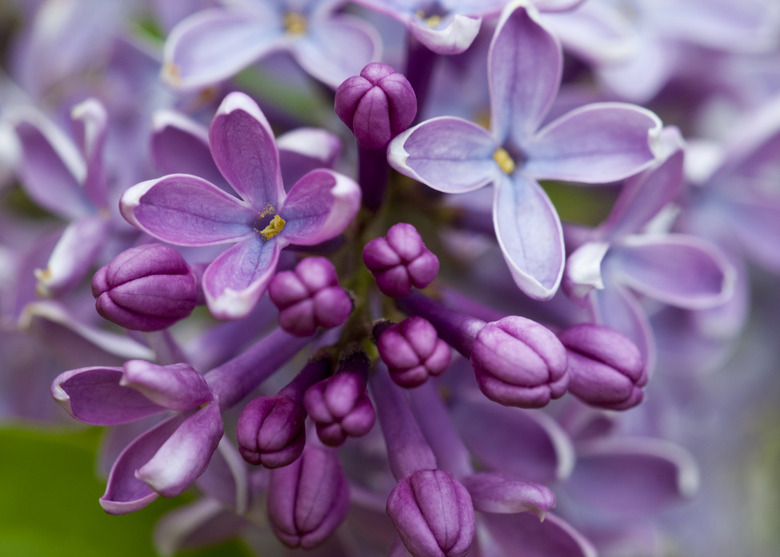How To Transplant Lilac Suckers
We may receive a commission on purchases made from links.
Lilac shrub blooms have a sweet smell and announce spring's arrival. Starting lilac plants from seeds or soft cuttings is a tricky procedure, but if a lilac shrub (Syringa spp.) grows on its own roots and produces colonies of little suckers around its base each spring, then you have enough makings for a hedge of lilacs.
Things Needed
-
Rubbing alcohol
-
Clean cloth
-
Bucket
How to Transplant Lilac Suckers
1. Know the Hardiness of the Lilac
Consider lilac hardiness. Common lilac (Syringa vulgaris) is hardy from U.S. Department of Agriculture plant hardiness zones 3 through 7, and USDA zones vary among other lilac varieties. If the lilac from which you will take suckers thrives in your yard or a neighbor's, then you needn't be concerned with its hardiness.
2. Choose a Sunny Area
Create a nursery area for the suckers before moving them, selecting a site that receives full sun. The corner of a garden or anywhere that a lawn mower or weed trimmer never goes will work. You could also prepare the area where the lilacs eventually will rest if you can provide it with a barrier to foot traffic and lawn equipment.
3. Prep the Area
Cultivate the selected area to a depth of at least 8 inches and a 2- to 3-foot diameter for each plant to encourage root development.
4. Mix in Compost
Add compost to make a well-drained loam if the soil is sandy or clay-heavy. Lilacs develop rot easily in soggy soil.
5. Choose Your Subjects
Choose suckers from a lilac that grows on its own roots. If a lilac's suckers have leaves that differ from those of its parent plant, then the parent was grafted to a rootstock from a hardier plant, and the suckers will not be like the parent.
6. Cut Ties to Parent Plant
Plan to take suckers that grow 1 foot or farther from the base of the shrub. You will sever the connection of each sucker to the parent plant while taking care not to damage the parent plant's root system.
7. Let Suckers Grow
Allow suckers to grow for one growing season before removing them. That time period allows them to develop sturdy root systems of their own, improving their chances of survival after they are removed.
8. Dig the Suckers
Remove suckers when the parent plant is dormant in early spring. If you live in an area where the ground does not freeze, then you might also transplant suckers in late winter.
9. Cut the Stolon
Push straight down with a sharp garden spade between the suckers and parent to sever the stolon — the root that connects them. Make your cuts 8 to 10 inches from each sucker.
10. Dig Up Suckers for Transplanting
Dig around roughly six suckers until you can pick them up. Knock the soil from their roots gently. Set the suckers in a bucket of tepid water. The water will keep the roots moist while you transport the suckers to their new home.
11. Plant the Suckers
Dig a hole 6 to 8 inches deep and wide for each sucker. Set each sucker in its hole, spreading its roots gently at the hole's bottom. Plant nursery plant lilacs so that their centers are at least 2 to 3 feet apart and so the plants are 6 to 8 feet apart in a hedge.
12. Gently Add Soil
Fill the remainder of each hole with soil gently, setting the sucker at the same soil depth at which it grew previously.
13. Mulch the Surrounding Area
Mulch the lilac sucker's soil surface with 2 to 3 inches of shredded pine or other organic mulch, keeping the mulch away from the suckers to protect them from stem rot rot.
14. Water the Lilacs
Water the soil to make it moist to a depth of 1 to 1 1/2 inches immediately after planting. Keep the soil moist for at least two weeks, until the suckers show new growth.
Tip
Clean the garden spade's blade edge frequently with a solution that is one-half rubbing alcohol and one-half water to leave soil-borne fungi in their place. Then wipe the blade dry with a clean cloth.
Cut unwanted suckers off below the ground with a pair of hand shears, using the rubbing alcohol-water solution to clean the tool's cutting surface after cuts made in soil.
Tie a string around each sucker at ground level to act as a guide for planting depth.
